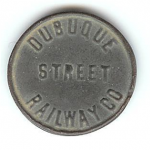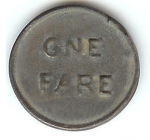Encyclopedia Dubuque
"Encyclopedia Dubuque is the online authority for all things Dubuque, written by the people who know the city best.”
Marshall Cohen—researcher and producer, CNN
Affiliated with the Local History Network of the State Historical Society of Iowa, and the Iowa Museum Association.
DUBUQUE STREET RAILWAY COMPANY
DUBUQUE STREET RAILWAY COMPANY. Organized on October 1, 1867, the company listed among its officers Platt SMITH, Julius K. GRAVES, Henry L. STOUT, and John THOMPSON. With capitalization at $75,000, contracts for building and supplying the route were signed with Charles Hathaway of Philadelphia, Pennsylvania.
By ordinance of October, 1867, the Dubuque Street Railway Company and their successors were granted "the exclusive right and privilege to construct, operate and maintain over the streets of the city of Dubuque street railways for carrying passengers and freight for the term of twenty years." (2) They were required to have at least two miles of track completed and in operation within one year. The first STREETCARS ran from the southern terminus of the ferry landing below Jones Street to Main and then north along Main to Thirteenth, to Clay, Eighteenth, and Couler Avenue. Continuing northward, the route ended at the fair grounds.
The first work on the street railway was done late in November, 1867, near Heeb's brewery; the first section ended at TIVOLI GARDENS. Extensions could be run to EAGLE POINT and the driving park. (3)
Five cars began operations on May 23, 1868, with fifteen horses.
The Company was leased to Platt Smith and James Hughes until 1876 when Joseph H. RHOMBERG, John J. LINEHAN, and Bart E. LINEHAN purchased the franchise and reduced the fare from ten cents to a nickel. Conductors on the cars were paid forty-five dollars per month. The STREETCARS, later equipped with storage batteries, ran their route so frequently that they passed each other every five minutes. A round trip took one hour.
By act of July, 1883, additional rights and privileges were granted to the company and additional requirements were exacted from it. (4)
In April, 1890, the right to operate an electric street railway was granted. Many provisions were added. In August, 1890, the company was granted the right to erect an electric light and power station within the city limits, and was limited to twenty-five years duration. Proper reservations were made by the city. By ordinance of September, 1890, the company was permitted to lay and maintain a double track on certain streets. In August, 1891, the ordinance concerning an electric street railway was amended and additional rights were granted — one provision being that regular cars should be run to the main entrance of the Dubuque Driving Park. (5)
An ordinance of February, 1892, permitted the company to extend its lines to certain other streets. The trolley wire was to be stretched in three directions. One would extend from the power house to the levee. Another would run along Clay Street and Rhomberg Avenue. The third would reach from the power house to the northern terminus of the line. In February 1892 J. A. Rhomberg purchased the one-half interest in the Dubuque Street Railway company owned by Mrs. J. J. Linehan for $142,000.
The car equipment of the new company was stated to be fifteen motor cars and ten new trailers. Each trailer would seat thirty people. The nine cars then equipped with storage batteries would be used on the overhead system without the storage batteries. A 350 horse power Corliss engine and a boiler of 100 horse power would be added to the power house which already contained a new Corliss engine of 725 horse power and two boilers each of 100 horse power. The storage battery cars were fourteen feet long. The overhead cars would be sixteen feet in length.
Additional rights were extended by the ordinance of July, 1897.
The life of the company was extended thirty-three years from April 25, 1915, and it was required "to construct, create, establish and permanently maintain a park and pleasure resort on both sides of the Maquoketa River at Sageville," and to create and maintain therein a lake to be formed by damming up the waters of that river, the dam to be built about 100 feet west of Thompson's Mill. The company was required to extend its lines to this park. The city reserved the right to purchase the entire plant of the street railway company and required half-fare tickets for working people during certain hours. (6)
See: LABOR MOVEMENT
---
Source:
1. Oldt, Franklin T. History of Dubuque County, Iowa. Chicago: Western Historical Company, 1880 http://www.ebooksread.com/authors-eng/franklin-t-oldt/history-of-dubuque-county-iowa-being-a-general-survey-of-dubuque-county-histor-tdl/page-17-history-of-dubuque-county-iowa-being-a-general-survey-of-dubuque-county-histor-tdl.shtml
2. Ibid.
3. Ibid.
4. Ibid.
5. Ibid.
6. Ibid.








